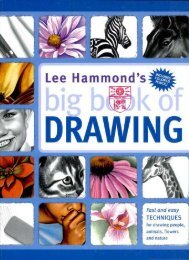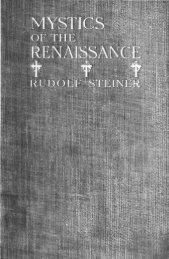The Supreme Doctrine - neo-alchemist
The Supreme Doctrine - neo-alchemist
The Supreme Doctrine - neo-alchemist
Create successful ePaper yourself
Turn your PDF publications into a flip-book with our unique Google optimized e-Paper software.
THE HORSEMAN AND THE HORSE<br />
actual state my life is necessarily egotistical, partial, natural, affective; when<br />
my thought functions independently of my affectivity it is independent of my<br />
personal life, of my life itself. In other words the horse represents my life,<br />
accompanied by partial thought; the rider represents my thought, pure, nonacting.<br />
I am the horse when my attention is seized by my life, I am the rider<br />
when my attention, escaping from this domination, arouses my Independent<br />
Intelligence.<br />
My conscious attention, which is a unity, could never be focussed at<br />
once on my life and on my pure thought that is above my life; it is necessarily<br />
focussed on one or the other of these two aspects of my being. <strong>The</strong> moments<br />
alternate during which, by means of my attention, I identify myself with the<br />
horse (when I feel and act), or again with the rider (when I think impartially).<br />
And it is because my surface consciousness alone is actually awakened in<br />
me—and that thus I can only be alternatively horse and rider—that I believe<br />
in the existence of a hiatus between these two parts although this hiatus does<br />
not exist in reality. <strong>The</strong> illusory hiatus between horse and rider is not a hiatus<br />
between two parts operating at the same time, but a false interpretation of the<br />
fact that I cannot be conscious at the same time of my partial life and of my<br />
impartial reason. If I had no memory this interpretation would not exist; it<br />
exists because I have a memory and because, thanks to this faculty, my<br />
imagination can evoke at once the two ways of being of which I am never<br />
conscious at one and the same time. In memory I picture myself<br />
imaginatively at once as horse and as rider, and thus I can see simulta<strong>neo</strong>usly<br />
the image of these two aspects of myself which never operate simulta<strong>neo</strong>usly<br />
for my surface consciousness; but because these two aspects never operate<br />
simulta<strong>neo</strong>usly for my surface consciousness the image which brings them<br />
together does not succeed in uniting them. It cannot be the image of a<br />
centaur; it is necessarily the image of a horseman mounted on a horse, with a<br />
hiatus between the two of them.<br />
Since the horse and the rider, defined thus as two ways of being, never<br />
operate consciously at the same time, the horse is never guided. We mean by<br />
that that the rider never guides the movement of the horse while this<br />
movement is taking place. Nevertheless the play of the rider has a directive<br />
action on the movements of the horse; but it is an indirect action and<br />
displaced in time. At the moment at which the rider is awakened (and at<br />
which the attention which animates him cannot be upon the horse), he sees,<br />
thanks to memory, how the horse has functioned the moment before and<br />
157




